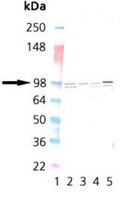208882 Sigma-AldrichAnti-Calnexin, N-Terminal (50-68) Rabbit pAb
Produits recommandés
Aperçu
| Replacement Information |
|---|
Tableau de caractéristiques principal
| Host |
|---|
| Rb |
| Product Information | |
|---|---|
| Form | Liquid |
| Formulation | In PBS, 50% glycerol, pH 7.2. |
| Preservative | ≤0.1% sodium azide |
| Biological Information | |
|---|---|
| Immunogen | a synthetic peptide (DTSAPTSPKVTYKAPVPSG) corresponding to amino acids 50-68 of canine calnexin, conjugated to KLH |
| Immunogen | Canine |
| Host | Rabbit |
| Isotype | IgG |
| Physicochemical Information |
|---|
| Dimensions |
|---|
| Materials Information |
|---|
| Toxicological Information |
|---|
| Safety Information according to GHS |
|---|
| Safety Information |
|---|
| Product Usage Statements |
|---|
| Packaging Information |
|---|
| Transport Information |
|---|
| Supplemental Information |
|---|
| Specifications |
|---|
| Global Trade Item Number | |
|---|---|
| Référence | GTIN |
| 208882 | 0 |
Documentation
Anti-Calnexin, N-Terminal (50-68) Rabbit pAb Certificats d'analyse
| Titre | Numéro de lot |
|---|---|
| 208882 |
Références bibliographiques
| Aperçu de la référence bibliographique |
|---|
| Le, A., et al. 1994. J. Biol. Chem. 269, 7514. David, V., et al. 1993. J. Biol. Chem. 268, 9585. Ahluwalia, N., et al. 1992. J. Biol. Chem. 267, 10914. Galvin, K., et al. 1992. Proc. Natl. Acad. Sci. USA 89, 8452. Hochstenbach, F., et al. 1992. Proc. Natl. Acad. Sci. USA 89, 4734. Wada, I., et al. 1991. J. Biol. Chem. 266, 19599. |








